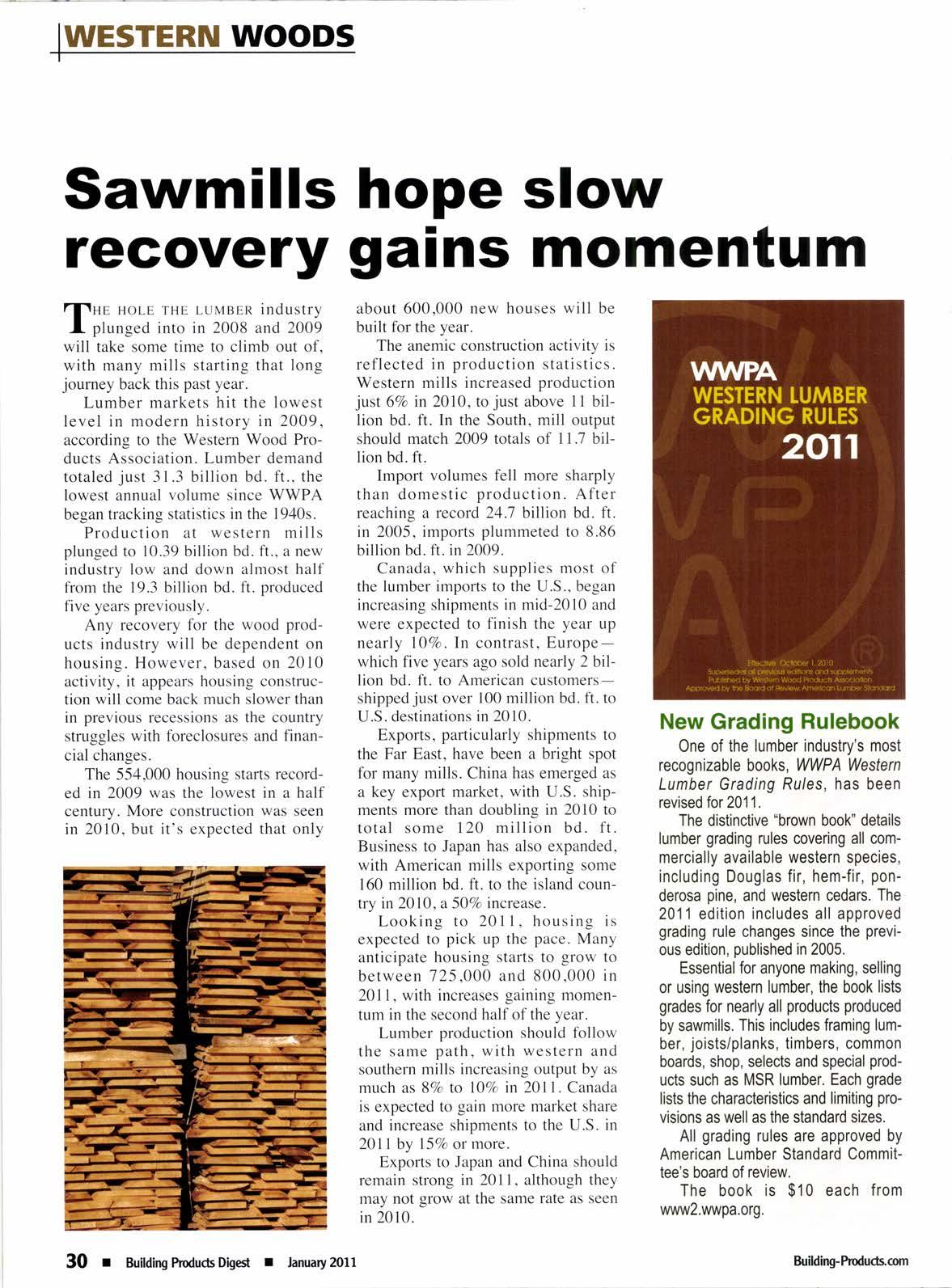
2 minute read
Sawmills hope slow recovery gains momentum
tTt"t HoLE rHE LU!IBER industry
I plunged into in 2008 and 2009 will take some time to climb out of, with many mills starting that long journey back this past year.
Lumber markets hit the lowest level in modern history in 2009, according to the Western Wood Products Association. Lumber demand totaled just 31.3 billion bd. ft., the lowest annual volume since WWPA began tracking statistics in the 1940s.
Production at western mills plunged to 10.39 billion bd. ft., a new industry low and down almost half from the 19.3 billion bd. ft. produced five years previously.
Any recovery for the wood products industry will be dependent on housing. However, based on 20 10 activity. it appears housing construction will come back much slower than in previous recessions as the country struggles with foreclosures and financial changes.
The 554000 housing starts recorded in 2009 was the lowest in a half century. More construction was seen in 2010, but it's expected that only about 600,000 new houses will be built for the year.
The anemic construction activity is reflected in production statistics. Western mills increased production just 67o in 2010, to just above 1 I billion bd. ft. In the South, mill output should match 2009 totals of I1.7 billion bd. ft.
Import volumes fell more sharply than domestic production. After reaching a record 24.7 billion bd. ft. in 2005, imports plummeted to 8.86 billion bd. ft. in 2009.
Canada, which supplies most of the lumber imports to the U.S., began increasing shipments in mid-2010 and were expected to finish the year up nearly 107o. ln contrast, Europewhich five years ago sold nearly 2 billion bd. ft. to American customersshipped just over 100 million bd. ft. to U.S. destinations in 2010.
Exports, particularly shipments to the Far East, have been a bright spot for many mills. China has emerged as a key export market, with U.S. shipments more than doubling in 2010 to total some 120 million bd. ft. Business to Japan has also expanded, with American mills exporting some 160 million bd. ft. to the island country in 2010, a 507o increase.
Looking to 2011, housing is expected to pick up the pace. Many anticipate housing starts to grow to between 125,000 and 800,000 in 20 I l. with increases gaining momentum in the second half of the year.
Lumber production should follow the same path, with western and southern mills increasing output by as much as 87o to 107o in 2011. Canada is expected to gain more market share and increase shipments to the U.S. in 2011 by 75Vo or morc.
Exports to Japan and China should remain strong in 2011, although they may not grow at the same rate as seen in 2010.
New Grading Rulebook
One of the lumber industry's most recognizable books, WWPA Western Lumber Grading Ru/es, has been revised for2011.
The distinctive "brown book" details lumber grading rules covering all commercially available western species, including Douglas fir, hem-fir, ponderosa pine, and western cedars. The 2011 edition includes all approved grading rule changes since the previous edition, published in 2005.
Essential for anyone making, selling or using western lumber, the book lists grades for nearly all products produced by sawmills. This includes framing lumber, joists/planks, timbers, common boards, shop, selects and special products such as MSR lumber. Each grade lists the characteristics and limiting provisions as well as the standard sizes.
All grading rules are approved by American Lumber Standard Commif tee's board of review.
The book is $10 each from www2.wwpa.org.

By Craig Larsen, Softwood Export Council










